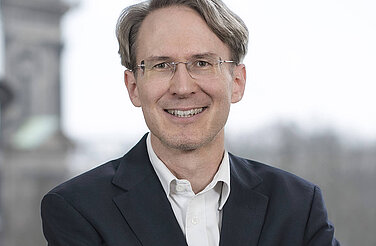-
The heating sector needs to phase out oil: A cost-efficient, climate friendly energy mix for building heating would most likely consist of 40 per cent natural gas, 25 per cent heat pumps, and 20 per cent district heating – with little to no oil.
In this scenario, the importance of natural gas remains roughly the same as today, while oil heating is almost entirely replaced by heat pumps. District heating is another key factor. By 2030, district heating will primarily draw on heat from CHP plants, but it will increasingly rely on solar thermal energy, deep geothermal energy, industrial waste heat, and large-scale heat pumps as well.
-
Efficiency is decisive: To meet 2030 targets, energy use for building heating must decline by 25 per cent relative to 2015 levels.
Energy efficiency is a pillar of decarbonisation because it makes climate protection affordable. Improving energy use efficiency in buildings requires a green retrofit rate of 2 per cent and a high retrofit depth. But current trends in building modernisation fall far short of these targets.
-
The heat pump gap: Based on current trends, some 2 million heat pumps will be installed by 2030 – but 5 to 6 million are needed.
To close this gap, heat pumps must be installed early on not only in new buildings but also in existing buildings, for example as bivalent systems with fossil fuel-fired boilers for peak demand. If heat pumps can be flexibly managed and existing storage heaters replaced with efficient heating units by 2030, the 5 to 6 million heat pumps will affect only a slight rise on peak demand that thermal power plants must cover.
-
Renewable electricity for heat pumps: By 2030, renewable energy must comprise at least 60 per cent of gross power consumption.
To reach the 2030 climate protection target, additional electricity consumption in the heating and traffic sector must be covered by CO2-free energy sources. But the new renewable energy capacities stipulated in EEG 2017 will not suffice to do so.
This content is also available in: German
Heat transition 2030
Key technologies for reaching the intermediate and long-term climate targets in the building sector

Preface
Among the targets set by the German government’s 2050 climate protection plan is one reserved specifically for the building sector: a reduction of annual greenhouse gas emissions to between 70 and 72 million tons of CO2 by 2030. Reaching this target will take a Wärmewende, a fundamental transformation in building heating technology and insulation. Such a transformation will have to rely on three cornerstones: energy efficiency, low-carbon district heating, and local renewable energy sources. But it is unclear how expansive these measures must be if Germany is to reach its environmental goals, especially given the ambitious targets for 2050.
To answer this question, we commissioned the Fraunhofer Institutes for Wind Energy and Energy System Technology (IWES) and for Building Physics (IBP) to identify the minimum levels of key technologies and approaches needed for decarbonisation. Their findings show that Germany must significantly boost efforts in green retrofitting, proliferating heat pumps, and expanding district heating to put the building sector on the right track.
Key findings
Bibliographical data
Downloads
-
Study
pdf 468 KB
Heat Transition 2030
Key technologies for reaching the intermediate and long-term climate targets in the building sector
-
Data Attachment
xlsx 289 KB
Heat transition 2030
The corresponding data appendix.
-
Translation
pdf 1 MB
2030 年供暖转型
Chinese translation


